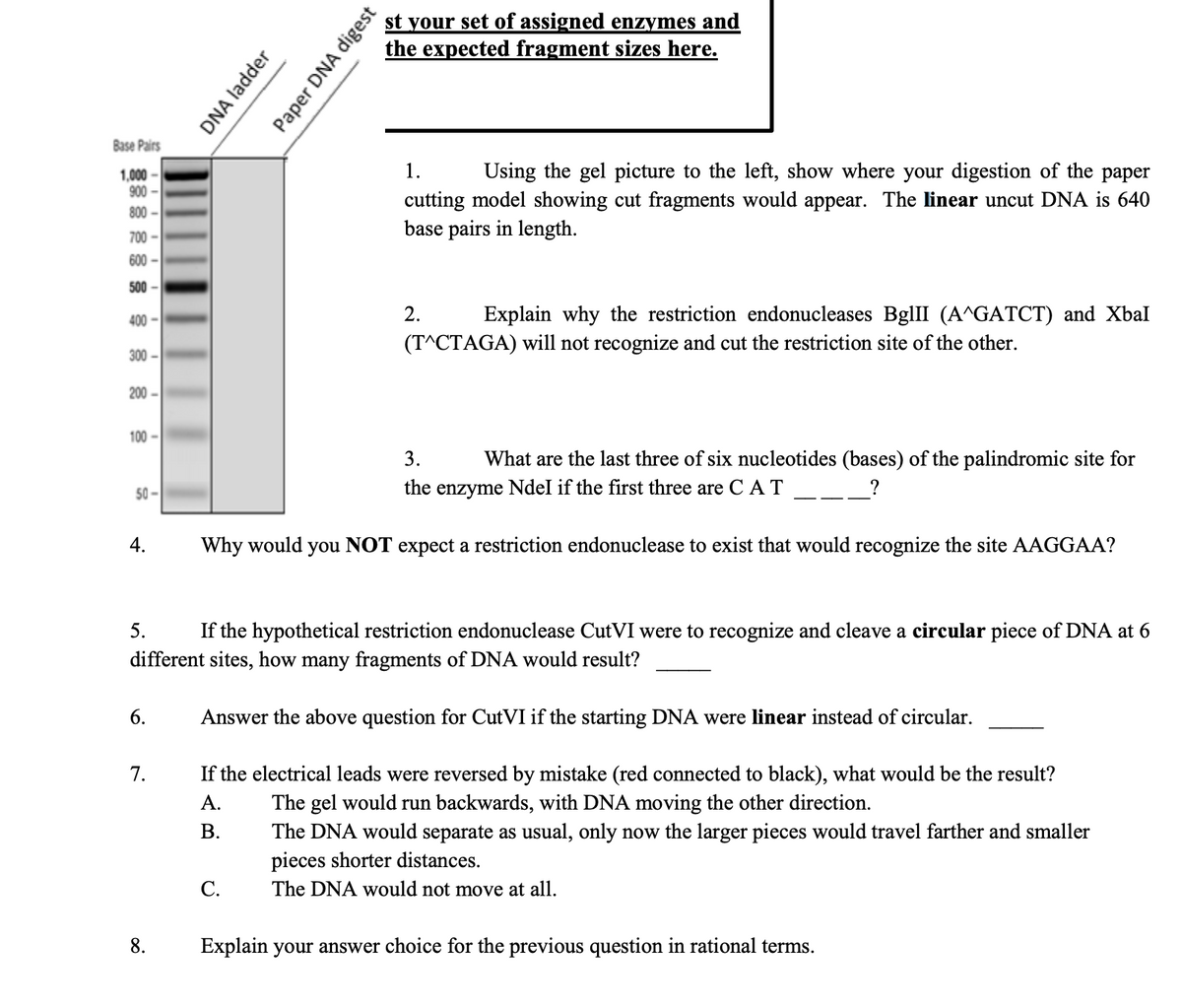Answer the above question for CutVI if the starting DNA were linear instead of circular.
Answer the above question for CutVI if the starting DNA were linear instead of circular.
Biochemistry
6th Edition
ISBN:9781305577206
Author:Reginald H. Garrett, Charles M. Grisham
Publisher:Reginald H. Garrett, Charles M. Grisham
Chapter28: Dna Metabolism: Replication, Recombination, And Repair
Section: Chapter Questions
Problem 1P: Semiconservative or Conservative DNA Replication If 15N-Iabeled E. coli DNA has a density of 1.724...
Related questions
Question
question 6

Transcribed Image Text:st your set of assigned enzymes and
the expected fragment sizes here.
Base Pairs
1.
Using the gel picture to the left, show where your digestion of the paper
1,000 -
900 -
cutting model showing cut fragments would appear. The linear uncut DNA is 640
base pairs in length.
800 -
700 -
600 -
500 -
400 -
2.
Explain why the restriction endonucleases BglII (A^GATCT) and Xbal
(T^CTAGA) will not recognize and cut the restriction site of the other.
300 -
200 -
100 -
3.
What are the last three of six nucleotides (bases) of the palindromic site for
50 -
the enzyme Ndel if the first three are C AT
?
4.
Why would you NOT expect a restriction endonuclease to exist that would recognize the site AAGGAA?
5.
If the hypothetical restriction endonuclease CutVI were to recognize and cleave a circular piece of DNA at 6
different sites, how many fragments of DNA would result?
6.
Answer the above question for CutVI if the starting DNA were linear instead of circular.
7.
If the electrical leads were reversed by mistake (red connected to black), what would be the result?
The gel would run backwards, with DNA moving the other direction.
The DNA would separate as usual, only now the larger pieces would travel farther and smaller
pieces shorter distances.
The DNA would not move at all.
A.
В.
С.
8.
Explain your answer choice for the previous question in rational terms.
DNA ladder
Paper DNA digest
Expert Solution
This question has been solved!
Explore an expertly crafted, step-by-step solution for a thorough understanding of key concepts.
This is a popular solution!
Trending now
This is a popular solution!
Step by step
Solved in 2 steps

Knowledge Booster
Learn more about
Need a deep-dive on the concept behind this application? Look no further. Learn more about this topic, biochemistry and related others by exploring similar questions and additional content below.Recommended textbooks for you

Biochemistry
Biochemistry
ISBN:
9781305577206
Author:
Reginald H. Garrett, Charles M. Grisham
Publisher:
Cengage Learning

Biology: The Dynamic Science (MindTap Course List)
Biology
ISBN:
9781305389892
Author:
Peter J. Russell, Paul E. Hertz, Beverly McMillan
Publisher:
Cengage Learning

Human Heredity: Principles and Issues (MindTap Co…
Biology
ISBN:
9781305251052
Author:
Michael Cummings
Publisher:
Cengage Learning

Biochemistry
Biochemistry
ISBN:
9781305577206
Author:
Reginald H. Garrett, Charles M. Grisham
Publisher:
Cengage Learning

Biology: The Dynamic Science (MindTap Course List)
Biology
ISBN:
9781305389892
Author:
Peter J. Russell, Paul E. Hertz, Beverly McMillan
Publisher:
Cengage Learning

Human Heredity: Principles and Issues (MindTap Co…
Biology
ISBN:
9781305251052
Author:
Michael Cummings
Publisher:
Cengage Learning
